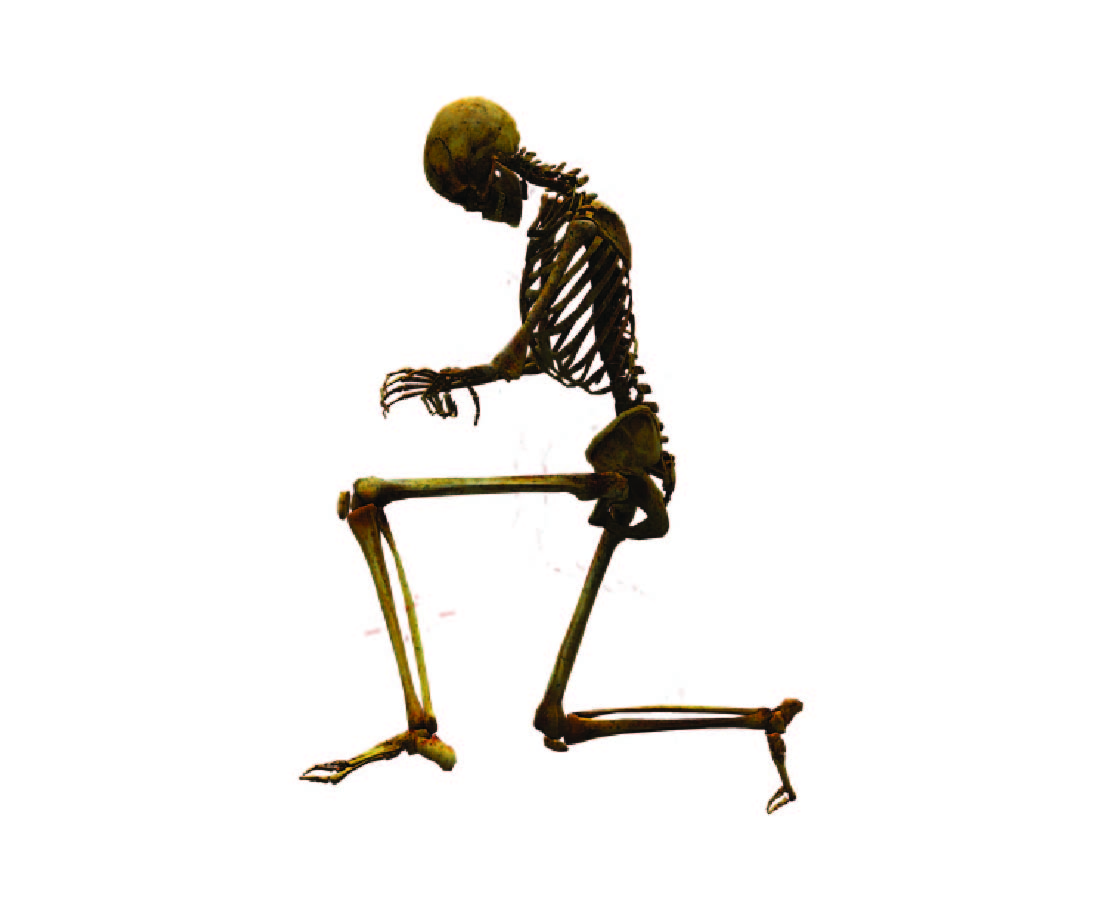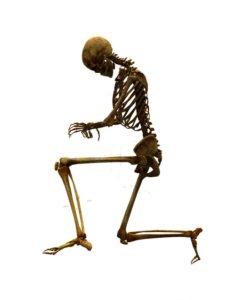
This article will examine some of the ways in which qigong is beneficial in reducing or avoiding the effects of osteoporosis. This is not an article about a single exercise or set of exercises specifically for osteoporosis, but rather an examination of how some of the general principles found throughout qigong can help with osteoporosis, because while it is possible to put together practices specifically aimed at the health of the bones, the beneficial principles are present in many qigong exercises, so any qigong practice is likely to be helpful. Understanding these principles will help to fine tune and guide your practice if this is an issue of interest to you.
Description of Osteoporosis and Factors Which Maintain Bone Density
To begin with I will give a brief description of osteoporosis. Osteo means bone, and porosis means porous or to have holes in it. Bones are a strong matrix of crystalline mineral structures bound together by collagen to keep their shape and give them tensile strength. They are not completely solid, as that would make them too heavy, but rather naturally have some degree of porosity that gives lightness as well as strength, but when the bones do not have enough density of minerals in their structure they become too porous and weak and prone to breaking easily. This is a common situation as people age, and often the first diagnosis of the condition is after a minor accident causes a fracture of some sort. By this time the bones are already weakened and susceptible to further breakages and the related negative health impacts that go along with them, so it is far better to take proactive measures to avoid or lessen the effects of osteoporosis ahead of time than to leave acting until after a diagnosis.

There are four primary factors that influence maintenance of bone density, and therefore the occurrence or avoidance of osteoporosis.
- Physical loading of the bones – especially compression and twisting or torsion through the bones.
- Electrical activity in the bones.
- Hormonal health and balance.
- Nutrition
Qigong can influence all of these factors positively in either direct or indirect ways, which makes it excellent for both prevention and gentle healing of osteoporosis.
Physical Stimulation From Qigong Affects Bone Density
The bones respond to the stresses that are placed on them. Within the structure of the bone are feedback mechanisms that tell the body how much and where exactly more minerals are needed. As forces are put on the bones, the body responds by increasing the density of the bone as needed, and even changing the shape of the bones to better handle the forces it encounters. The general thinking is that the stronger the physical stimulus on the bone, the more effective it will be at encouraging maintenance of bone density. This is one reason why osteoporosis is associated with age. As people get older they tend to be less physically active, and so their bodies do not receive the signals that they need to send minerals to the bones.
There are numerous qigong exercises that put significant force through the bones in a relatively gentle way. There a many examples of these in the Wild Animal Play practices, and the Thunder and Lighting exercises at the end of the Waking the Qi series are also great for this. But there are a few other details of how qigong is practiced that mean that you do not need as strong a compressive force as may be needed in other types of physical activity in order for it to provide stimulus to the body to increase or maintain bone density. When we practice qigong we are mindful of the energy moving through our body. We concentrate on feeling the movement of force and making it smooth. When we are not mindful of the energy moving through our body, the force will often move in a jerky way, putting too much stress on some parts, and not fully stimulating others. The slow movements of qigong, while gentle, smoothly stimulate all the cells of the body as the physical force moves through – including the bones. This means that the bones receive the stimulus that they need to encourage healthy bone density, without necessarily needing the same intensity of force as would be required from another less mindful type of movement activity, because with qigong we are applying that force to our bones in a much more efficient way than we might with another activity.
A very simple qigong movement such as Rise and Fall will serve to demonstrate this principle – but the same principle is found throughout all moving qigong practices.
Electrical Activity in the Bones is Stimulated By Qigong
The mechanism that the body uses bring minerals into the bone matrix is very simple and direct. When force is applied to a bone it actually creates a change in electrical potential which attracts the charged ions of the relevant minerals in the body (Calcium, Magnesium, etc) into the bone where they can be bonded into the bone’s structure to provide additional strength. As with the efficient application of physical force to the bone, the mindful nature of qigong makes this electrical part of the process more efficient as well. This is because as well as tuning our awareness to the movement of physical force through the body as we practice qigong, we also tune into the other energy sensations that accompany the physical sensation – including electrical sensations! The sensations arising from electrical activity in the body are often felt as magnetic, tingling, buzzing, or even slightly numb type sensations. When we focus on something with our mind, we can lead our body to make that thing stronger, and that is something that we commonly do with electrical sensations as we practice qigong.
A simple energy awareness exercise will illustrate this point. But again, this same principle occurs throughout qigong practices.
Hormonal Health and Balance
The hormones also play an important role in maintaining bone density, particularly estrogen levels. This is one reason why females are more prone to osteoporosis as they age and their estrogen levels fall. Hormones in the human body do not work individually, but in concert with all of the other hormones in the system as well. Many qigong practices work in either direct or indirect ways to balance and maintain healthy hormone levels. Some Long White Cloud Qigong practices that have particularly direct effects on hormones are Twelve Rivers which stimulates and balances the internal organs and also the hormones relating to their functions, Emotional Alchemy sounds which use sound vibration to massage the organs and release emotions relating to different organs and hormones (you can get access to a mini course on the Emotional Alchemy sounds by signing up to our email newsletter at the bottom of this blog, or if you are on our email list already and missed that course somehow, you can just send us an email and we will send you the link), and Waking the Qi which works specifically with the hormones relating to the Kidneys and the Brain. By keeping the whole hormonal system healthy and balanced we support healthy estrogen levels and bone density!
Nutrition
Qigong’s effect on your nutrition will likely be quite indirect. But as you move your body, balance your hormones, elevate your mood, and relieve stress from the healthy gentle exercise of qigong, it is likely that you will naturally feel more inclined to eat a healthy and balanced diet. Often people know what they should be eating, but the imbalances in their body due to stress and other factors leave them with impulses to eat in a way that does not support their overall health. Introducing regular qigong into your routine can create a positive feedback cycle where little by little you start to feel better, and this leads to you naturally also being drawn to eat better as well. In addition to this, through your qigong practice you naturally learn to be more aware of your body and its needs, and you will be more able to recognize the specific foods your body needs most to gain the nutrition that is most beneficial too it.
Conclusion
I hope you have found this article useful and informative. If you already practice qigong, then I hope that this has helped you to better understand some of the benefits that you get from it that can help you to live a healthy, active, and abundant life well into old age. If you do not practice qigong yet, you may be interested in looking at some of the online qigong courses that Long White Cloud Qigong offers. You can find these here. If you have any questions about how it would be best for you to start, feel free to email us here.
If you enjoyed this article, and would like to stay up to date with future articles and news as they come out, you are welcome to join our newsletter list by entering your email in the box below!
Yours in qi!
John Munro
1 Comment. Leave new
As someone with osteopenia and osteoarthritis I find Qigong is invaluable to help keep me in shape, flexible, have good balance, and without pain. One of the reasons I started Qigong and became an instructor was to help myself and others with similar issues.